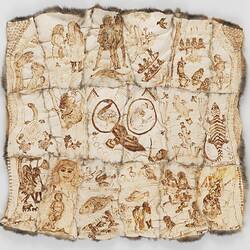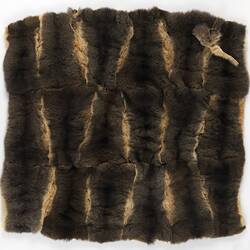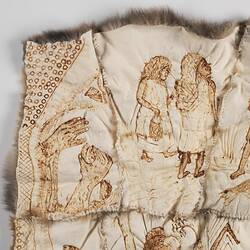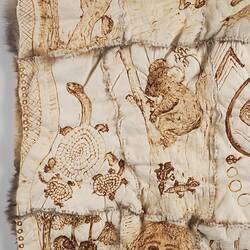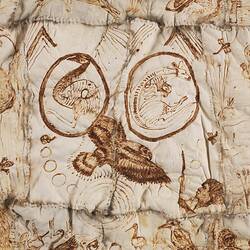Summary
Possum skin cloak made by Phoebe Nicholson in 2013 for the First Peoples exhibition. Phoebe is an artist, Wemba Wemba and Barapa Barapa Elder and healer who uses cloaks for community and cultural activities and as a form of cultural healing. She works with her son and daughter, and her community, to tell contemporary stories about the country of the Wadi Wadi language group on her possum skin cloak.
Possum skin cloaks are an important repository of knowledge and hold information vital to contemporary Aboriginal identity. They feature distinct markings representing clans and country. This is evident in Aunty Phoebe's cloak which features scenes from Barapa Barapa and Wemba Wemba country on the Murray River. The designs show healing ceremonies and activities and scenes of cultural life on the river.
Physical Description
Possum skin cloak comprising eighteen pelts sewn together edge to edge with synthetic cord. Fur side with toggle for clasp. Reverse side highly decorated with detailed art using hot pokerwork method. One pelt: Pair of hands incising pelt with shell. Two pelts: Two women with baskets and two men with shield, spear and kangaroo. One pelt: River scene - one canoe with three people, another canoe with four people, scarred tree. One pelt: Dance scene - three men dancing, four seated figures, fire, spears. One pelt: Returning hunter carrying kangaroo over his shoulder. One pelt: Three turtles. One pelt: Koala and two lizards on a tree. Two pelts: Central; two carved emu eggs, an eagle and a man looking upwards. One pelt: Two platypus, dragonflies and water reeds. One pelt: Striped goanna. One pelt: Man and woman walking. Both wear cloaks, two companion dogs, shelter in background. One pelt: Portrait of woman and sleeping baby. One pelt: Two people tending fish traps (full of fish), fish in water, water birds - ibis, duck, pelican feeding on the river bank. One pelt: Two figures carrying fish, fish, waterbirds on the river bank - ibis and kookaburra. One pelt: Family camp scene - one woman making a cloak, one person sitting/talking, children playing, two women sitting. One pelt: Four figures preparing possum skins - pegging, skins on drying racks. Cloak is edged with circular and cross hatching patterns. Bottom right corner 'P. Nicholson/mij 2013'.
Significance
This cloak provides an insight into contemporary Aboriginal cloak-making, cultural revival and transference of knowledge from elders to the next generation. It is a strong reminder that despite over 200 years of colonisation, Aboriginal Victorians continue to practice an important tradition which bridges knowledge and generations.
More Information
-
Object/Medium
Cloak
-
Maker
-
Cultural Groups
-
Locality
-
Date Produced
-
Fully Extended
1100 mm (Length), 1130 mm (Width), 50 mm (Height)
-
Keywords
-
Type of item
-
Discipline
-
Category
-
Collecting Areas
Australian Indigenous Identity and Contemporary Life, Australian Indigenous - South-eastern Australia

